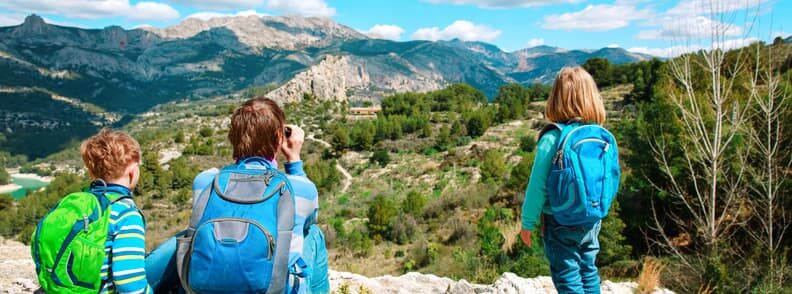Few outdoor pursuits can compare to the exciting sensation of trekking through Spain’s rugged and gorgeous landscape. The nation is a haven for hikers of all skill levels because of its diverse landscapes, which vary from towering mountains and undulating hills to coastal cliffs and breathtaking national parks.
It makes sense that one of the most popular activities in Spain for both locals and visitors is hiking. Many routes in the nation, each with its own distinctive beauty and degree of difficulty, draw hikers from all over the world. There is always a path that meets your interests, whether you are an experienced hiker or a novice.
Does Spain have good hiking?
With some of Europe’s most beautiful natural scenery, Spain is a hidden jewel for hikers. Spain’s varied topography, which ranges from the sandy beaches of the Costa Brava to the snow-capped summits of the Sierra Nevada, is ideal for hikers of all skill levels. There is a hike in Spain for every traveler, from the seasoned hiker seeking a strenuous climb to the novice wanting a picturesque stroll.
Spain’s distinctive topography is only one of the reasons it’s such a fantastic and popular hiking destination. This country is home to a variety of mountain ranges, such as the Pyrenees, Sierra de Grazalema, and Picos de Europa, together with a number of natural parks and reserves. These places await travelers with breathtaking scenery, from rocky peaks to lush valleys, and are home to a variety of flora and animals.
Spain’s climate is another factor making it a great place to go trekking. Although the optimal time to walk varies by geography and altitude, with more than 300 days of sunshine each year, hikers may enjoy trails all year long. The finest seasons for hiking are often spring (March to May) and fall (September to November), when the weather is warmer and the scenery is at its most vibrant.
Also, hiking in Spain is a fantastic opportunity to become immersed in the Spanish way of life. Several of the trails pass by quaint towns where you may get a taste of the regional traditions and food. During the trip, you may stop at historical locations including monasteries, castles, and prehistoric remains.
In conclusion, Spain is a great place to go hiking since it offers a variety of landscapes, great weather, and chances to learn about the local culture. Everyone can find something to enjoy in this stunning country because there are so many Spain hikes to select from.
This article will explore some of Spain’s most magnificent hiking paths as we delve deeper into the country’s hiking culture. The top 15 hikes in Spain will be covered, along with all the pertinent information you want, such as the difficulty level, the ideal time to walk, and what to anticipate while hiking.
This travel blog post offers everything you need to plan your next hiking journey in Spain, from the fabled Camino de Santiago to the untamed Picos de Europa National Park and the breathtaking Costa Brava coastline. There are activities for everyone, whether they want a strenuous multi-day hike or a leisurely stroll around the countryside. So let’s explore the world of hiking in Spain!
15 Best hikes in Spain
The top 15 hikes and walks in Spain will be discussed in detail in this section. From the well-known Camino de Santiago to the lesser-known but no less stunning Riao, each trail from this list provides hikers of all skill levels with a distinctive experience. Each path will be briefly described, along with its difficulty level, ideal hiking season, and expected side effects.
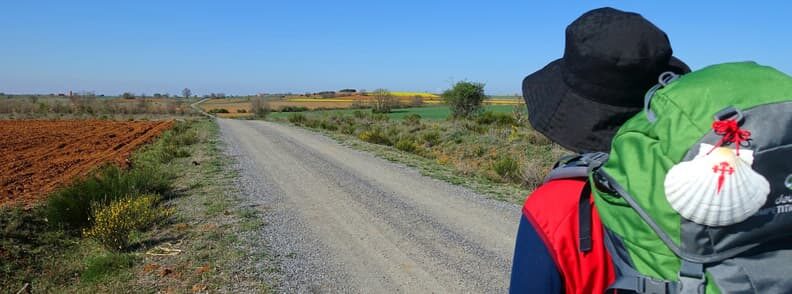
1. Camino de Santiago
The Camino de Santiago, often known as the Way of St. James, is one of the world’s most well-known and historic hiking pathways. The path extends over 800 kilometers and takes walkers from the Pyrenees Mountains to the city of Santiago de Compostela in northern Spain.
The Camino de Santiago is a spiritual trip that stretches back to the 9th century when it was thought that St. James the Apostle was buried at Santiago de Compostela. The trail has become a pilgrimage route for pilgrims from all over the world throughout the ages, and it is now a UNESCO World Heritage Site.
In terms of difficulty, the Camino de Santiago ranges from moderate to strenuous, depending on the route and the hiker’s pace. Hikers can walk as much or as little as they choose each day on the well-marked track. Some parts of the path are steep and difficult, while others are flat and simple.
The optimum season to trek the Camino de Santiago is from May to October when the weather is at its finest. Hikers should expect temperate temperatures and bright skies around this time, allowing for good trekking conditions. Nonetheless, hikers should bear in mind that the path may get rather crowded during peak season, so prepare appropriately.
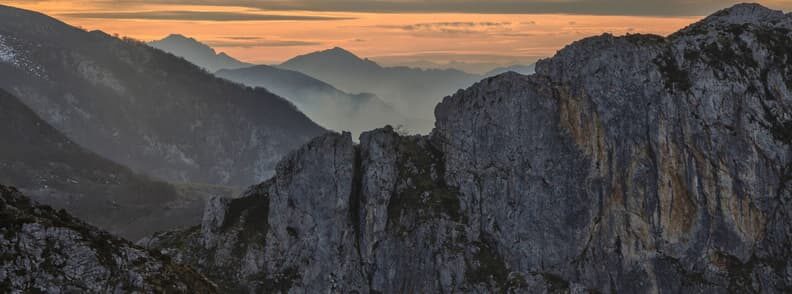
2. Picos de Europa National Park
Picos de Europa National Park is tucked away in northern Spain. It’s a hidden jewel that provides some of the most spectacular hiking opportunities in the country. The park is a must-visit location for hikers and environment lovers due to its rocky peaks, deep canyons, and magnificent glacier lakes.
From short strolls to strenuous multi-day excursions, the Picos de Europa National Park has a variety of hiking paths appropriate for all skill levels. The Ruta del Cares, which travels for more than 11 kilometers over a breathtaking ravine, is one of the most well-known roads. The hike can be difficult at times, with steep inclines and winding roads, but it is well worth the effort for the breathtaking views of the canyon and the nearby mountains.
A must-do for more seasoned hikers is the trek to Pico Urriellu’s top. The breathtaking panoramic views from the peak are absolutely unforgettable, despite the strenuous hike’s rocky terrain and steep ascents.
May through October, when the weather is most agreeable, is the greatest time to go hiking in the Picos de Europa National Park. Hikers may anticipate warm temperatures and bright skies at this time, which will provide for comfortable trekking conditions. Yet, it’s vital to have the right hiking equipment, as the weather can abruptly change and temperatures might dip at higher heights.
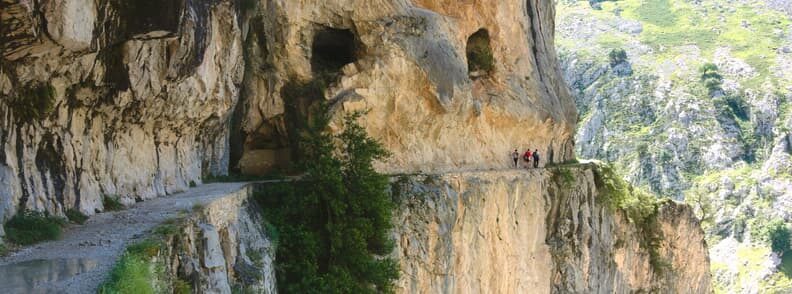
3. Ruta del Cares
One of Spain’s most well-known hiking trails, Ruta del Cares, commonly known as the Cares Gorge Trail, provides hikers with breathtaking views of the Picos de Europa mountain range. Steep cliffs rise up on each side of the route as it follows the Cares River through a stunning valley.
Starting in Poncebos and finishing at the community of Caín, the trail is about 12 kilometers long. The route should take hikers four to five hours to complete because the way is clearly defined. Hikers will pass over a number of bridges, tunnels, and breathtaking vistas that provide expansive views of the nearby mountains and valleys.
Ruta del Cares is a moderately challenging trek that is appropriate for hikers of all skill levels. Although there are some steep areas and tight trails on the trail, it is typically simple to travel and does not call for any specialized knowledge. The terrain can be treacherous in certain places, so it’s crucial to come equipped with the right hiking equipment and to use caution in rainy or icy circumstances.
The best period to hike Ruta del Cares is from May to October when the weather is at its finest. Hikers should expect temperate temperatures and bright skies around this time, allowing for good trekking conditions. But, because there is little shade throughout the walk, it is critical to bring lots of water, sunscreen, and a hat.
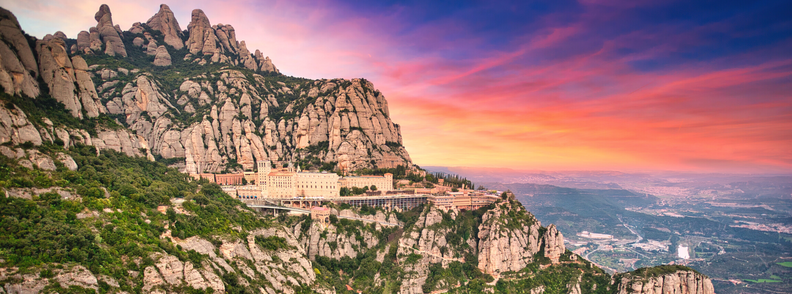
4. Montserrat
Montserrat is a magnificent mountain range located only a short distance from Barcelona that provides some of the greatest hiking experiences in Spain. Montserrat is a must-see destination for hikers and environment enthusiasts, with its distinctive rock formations, spectacular peaks, and spiritual importance.
The mountain range is home to various hiking paths varying in intensity from casual walks to more strenuous hikes. The Camino de Sant Jaume, which takes walkers into the center of the mountain range and passes through some of the most renowned locations along the way, including the Montserrat Monastery, is one of the most popular routes.
The trek to the peak of Sant Jeroni is a must-do for more experienced hikers. This difficult climb includes steep ascents and rocky terrain, but the breathtaking panoramic views from the peak are absolutely unforgettable.
Hiking in Montserrat is best done in the spring and fall, from April to June and September to November. Hikers should expect pleasant temperatures and bright skies during these months, allowing for ideal trekking conditions. Please note that the summer months can be rather hot, with temperatures reaching up to 30°C, thus trekking should be avoided during this time.
Montserrat hikes range in complexity from basic to strenuous, so there is something for hikers of all levels of expertise. Nonetheless, it is important to come equipped with suitable hiking gear and to use caution on the higher areas of the trail.
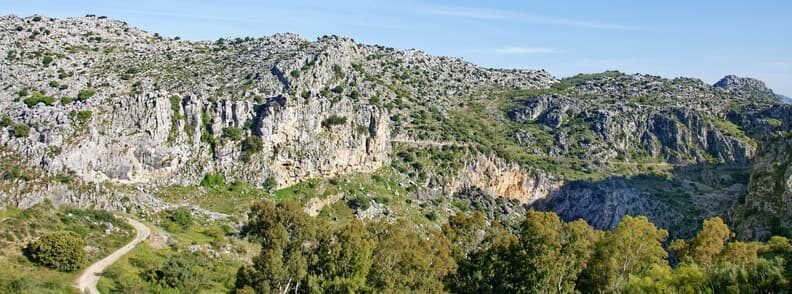
5. Sierra de Grazalema Natural Park
Some of Spain’s most beautiful hikes in Spain are to be discovered in Sierra de Grazalema Natural Park. Located in the Andalusia province of Cadiz, Sierra de Granzalema is a hiking and nature enthusiast’s heaven because of its rough mountain ranges, narrow valleys, and dense woods.
The park has a broad range of hiking paths, from leisurely strolls to strenuous hikes. The Garganta Verde path, which leads hikers through a breathtaking gorge with sloping cliffs that reach heights of 400 meters, is one of the most well-liked routes. Hikers may take in the breathtaking scenery and witness vultures flying above as they travel.
The hike to the top of El Torreon is a must-do for anyone looking for a more difficult trip. Hikers can access the highest point in the park through this challenging trek, which offers expansive views of the neighboring mountain ranges.
There is something for hikers of all levels of expertise because the walks in Sierra de Grazalema Natural Park range in difficulty from simple to challenging. But, it’s crucial to arrive equipped with the right hiking equipment and to exercise caution on the trail’s harder portions.
The months of April to June and September to November are the finest for hiking in the Sierra de Grazalema Natural Park. Hikers should anticipate pleasant temperatures and clear skies throughout these months, which makes for ideal trekking conditions. It’s important to keep in mind that the summer months can get rather hot, with highs of up to 40°C, therefore trekking is not advised during this time.
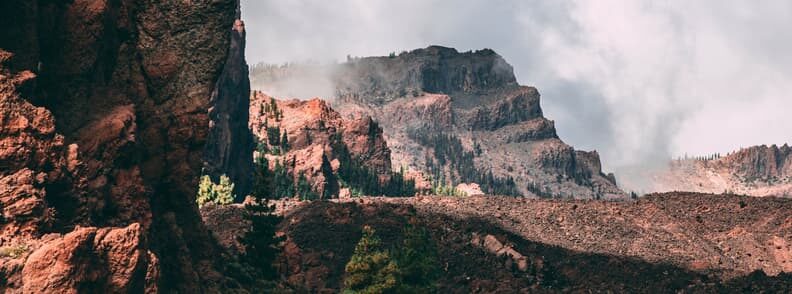
6. Teide National Park
In the Canary Island of Tenerife, Teide National Park is a distinctive hiking location. The park is home to the enormous volcanic Mount Teide, Spain’s highest peak at more than 3,700 meters. Teide National Park is a must-visit location for hikers and environment enthusiasts because of its lunar-like topography, varied flora and wildlife, and breathtaking views.
The park has a selection of hiking routes that range in intensity from short strolls to strenuous excursions. The Teide Summit Path, which leads hikers on a strenuous trek to Mount Teide’s peak, is one of the most well-liked routes. A decent degree of fitness and appropriate hiking equipment is required for the steep and rocky trek. Yet the summit’s breathtaking panoramic vistas will be with you forever.
The Roques de Garcia Trail is an excellent choice if you want a more leisurely stroll. Travelers can enjoy a leisurely stroll amid the park’s distinctive rock formations, including the well-known Roque Cinchado and Roque de García, on this straightforward track.
The months of April through June and September through November are the finest for hiking in Teide National Park. Hikers should anticipate pleasant temperatures and bright skies throughout these months, which make for ideal trekking conditions. It’s important to keep in mind that the winter and summer months’ temperatures vary a lot from cold and snowy to very hot, with highs of up to 30°C. It is thus advised to avoid trekking during these seasons.
The treks in Teide National Park range in intensity from basic to strenuous, so there is something for hikers of all skill levels. But, it’s crucial to arrive equipped with the right hiking equipment and to exercise caution on the trail’s harder portions.
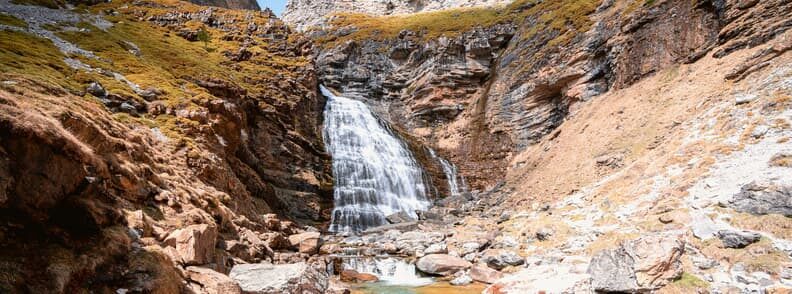
7. Ordesa y Monte Perdido National Park
Northern Spain’s Pyrenees Mountains are home to the magnificent hiking destination Ordesa y Monte Perdido National Park. This park has some of Spain’s most beautiful scenery, including deep valleys, lofty peaks, and dense woods. Ordesa y Monte Perdido National Park is a must-visit destination for outdoor enthusiasts thanks to its varied hiking paths and stunning vistas.
This park has a selection of hiking routes that range in intensity from short strolls to strenuous excursions. The Ordesa Valley Trail, which leads hikers on a leisurely stroll through the park’s lush woodlands and beside the banks of the Ara River, is one of the most well-liked trails. The Monte Perdido Trail, one of the highest summits in the Pyrenees, leads hikers on a more strenuous trek to the summit of Mount Perdido.
The summer months, from June to September, are the greatest for hiking in the Ordesa y Monte Perdido National Park since the weather is moderate and the trails are open. Remember that the park can get quite busy at this period, therefore it’s advised to arrive early in the morning to escape the crowds.
There is something for hikers of all levels of expertise because the walks in Ordesa y Monte Perdido National Park range in difficulty from simple to demanding. But, it’s essential to arrive equipped with the right hiking equipment and to exercise caution on the trail’s harder portions.
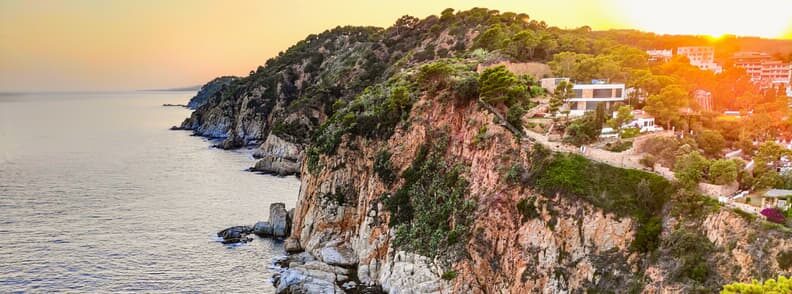
8. Costa Brava
Spain’s northeastern coast or Costa Brava runs along the Mediterranean Sea and is known for its gorgeous scenery. Hikers who wish to take in the unspoiled Mediterranean coast’s natural splendor, discover quaint communities, and soak up the sun should head there. The Costa Brava has a wide variety of hiking paths that vary from leisurely walks along the beaches to strenuous excursions across rocky terrain, so there is something for everyone.
Many hiking paths, varying in difficulty, length, and topography can be found across the Costa Brava. The Cam de Ronda is one of the most well-known walks; it is a 200-kilometer coastal trail that runs from Blanes to Portbou. Enjoy breathtaking views of the Mediterranean while traveling through little villages, quiet bays, and rocky cliffs on this walk.
The intensity of the treks in Costa Brava varies; some are appropriate for beginners, while others call for more advanced physical preparedness and expertise. For instance, the Cam de Ronda includes a few difficult stretches with steep hills and uneven ground. Before starting a trek, it’s crucial to evaluate the trail’s degree of difficulty and pack the appropriate gear.
The spring and autumn, from March to May and from September to November, are the greatest seasons for hiking in Costa Brava since the weather is moderate and there are fewer tourists around. Hiking can be difficult in the hot, muggy summer months due to the high tourist traffic on the Costa Brava. The best time to go trekking, swimming, and tanning on the beaches is, however, during the summer.
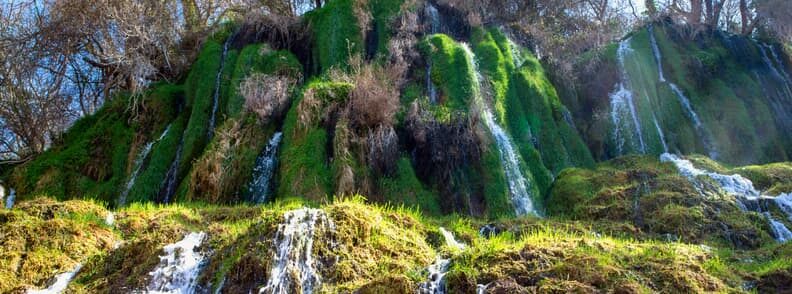
9. Monasterio de Piedra Natural Park
Monasterio de Piedra Natural Park from the province of Zaragoza is an incredibly stunning natural park with a wide variety of landscapes, including sparkling waterfalls, lush woods, and serene lakes. This is the perfect place to go for hikers who wish to discover the splendor of Spain’s natural landscapes.
From short strolls to strenuous hikes, Monasterio de Piedra Natural Park’s variety of trails can accommodate hikers of all skill levels. For example, the Waterfall Trail — one of the most popular walks — leads visitors past a number of flowing waterfalls, steep gorges, and thick woods. All hikers can use the path no matter their fitness level because it is only around 5 kilometers long and moderately tough.
Los Cahorros trail is a fantastic choice for anyone looking for a more difficult walk. This walk offers hikers breathtaking views of the surroundings as they ascend steep inclines, pass through tight gorges, and over suspended bridges. It’s best suited for hikers with some experience and a respectable degree of fitness because the trip is around 8 kilometers long and quite demanding.
Hiking at Monasterio de Piedra Natural Park is best done in the spring and fall when the weather is warm and the park’s flora and animals are at their most beautiful. During summer, temperatures can increase significantly and the place can become congested with visitors. In contrast, this area can suffer significant rains during the winter months, making some of the routes impossible to travel due to flooding.
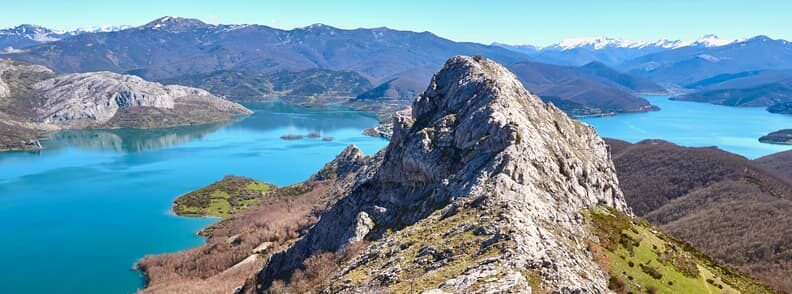
10. Riaño
Riaño is a beautiful mountainous region in the Leon province of Spain. With various routes suitable for walkers of all skill levels, the area is a hiker’s paradise. especially because of the stunning views of the wild landscape around. Riaño has much to offer everyone, from leisurely strolls through beautiful forests to strenuous hikes up steep inclines.
The trail that leads to Peña Ubiña, the region’s highest mountain, is one of the most well-liked walks in Riaño. It is recommended for hikers with some experience and a decent level of fitness because the path is around 14 kilometers long and has a moderate to difficult difficulty level. The strenuous trek is worthwhile, though, because of the breathtaking vistas that can be seen from the peak.
The route leading to the stunning Lake Ausente is a fantastic choice for those looking for a simpler hike in Riaño. The trail offers breathtaking views of the surroundings as it leads hikers through lovely woodlands and along the serene shores of the lake. The path is suited for hikers of all skill levels because it is around 7 kilometers long and is categorized as easy.
The best months to go hiking in Riaño are during spring and autumn when the weather is moderate and the scenery is at its most colorful. Some of the trails can be challenging to negotiate in the summer due to the high heat, while some of the higher paths can become impassable due to heavy snowfall in the winter.
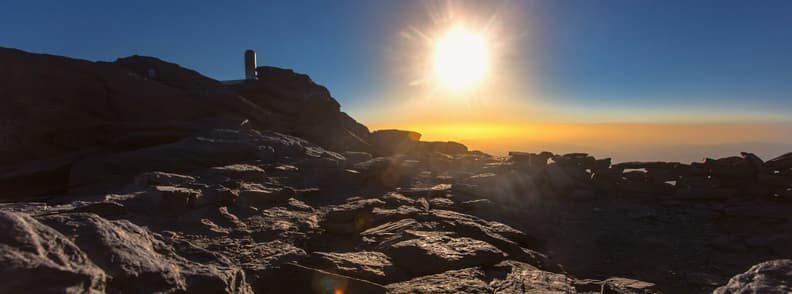
11. Mulhacén
The Sierra Nevada mountain range is dominated by the highest peak in Spanish mainland territory, Mulhacén, which rises 3,479 meters above sea level. Hikers seeking a challenge and breathtaking vistas of the surroundings frequently visit this location. The lengthy and steep trek to the peak is one of the toughest hikes in the nation and calls for a high degree of fitness and expertise.
The Hoya del Portillo, a picturesque valley encircled by impressive peaks, is where the route to Mulhacén begins. After that, hikers will go up the mountain on a steep trail that twists through woods and rugged terrain until reaching the peak. The trek is around 18 kilometers long and is considered a challenging hike.
The summer months, from June to September, are ideal for hiking Mulhacén since the weather is warmer and the paths are easier to reach. Hikers should be ready for rapid weather changes even in the summer, as storms can move in swiftly, especially at higher elevations.
Although the trek is difficult, the reward at the peak is well worth the effort. Beautiful panoramic views of the Sierra Nevada mountain range and the surroundings are available to hikers. On a clear day, you can see all the way to the Mediterranean Sea from the summit, making it an experience they won’t soon forget.
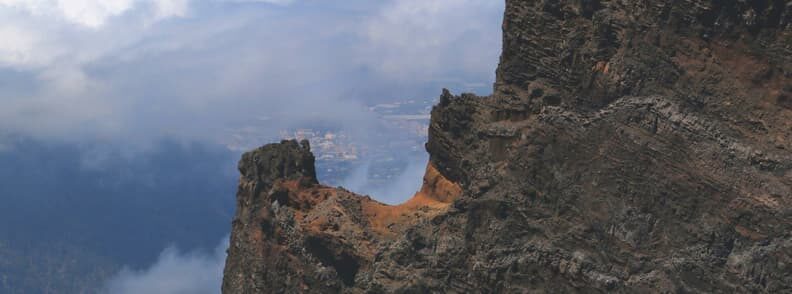
12. Caldera de Taburiente National Park
Caldera de Taburiente National Park is a hiker’s paradise located on the stunning island of La Palma in the Canary Islands. This natural park provides hikers of all skills and fitness levels with an amazing trekking experience because of its challenging terrain, breathtaking scenery, and variety of hiking paths.
The Caldera de Taburiente, a massive crater-like structure encircled by rocky walls and peaks that soar beyond 2,000 meters in height, is the centerpiece of the park. The Caldera and the surrounding woods, gorges, and waterfalls can all be seen in exquisite detail from the park’s hiking trails. The park is also home to a wide variety of vegetation, animals, and uncommon bird species that are unique to the planet.
Hikers can pick from a wide range of paths throughout the park, from short strolls to strenuous hikes that take several days to complete. The Ruta de Los Volcanes, a 19-kilometer trek across the park’s volcanic scenery that offers breathtaking views of the Caldera and the surrounding peaks, is one of the most well-known walks in the area.
The greatest seasons for hiking in Caldera de Taburiente National Park are spring and fall when the weather is moderate and the area is at its most alive. It might be challenging to negotiate some of the higher routes during the hot, humid summer months and the chilly, wet winter months.
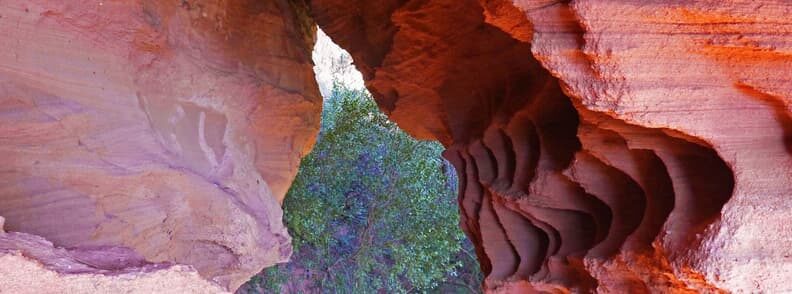
13. Montsant Natural Park
Montsant Natural Park in the Catalan province of Tarragona welcomes travelers who hike in Spain with breathtaking views of the region’s craggy mountains, narrow valleys, and dense woods. At 9,000 hectares in size, the park attracts hikers of all skill levels with its distinctive topography and variety of hiking trails.
Experienced hikers who travel to Spain’s Montsant Natural Park seeking a challenge will find its harsh landscape with high cliffs, rocky outcrops, and deep gorges to be the perfect getaway. The Roca Corbatera is a strenuous climb that leads hikers on a 12-kilometer excursion across the park’s rugged terrain and offers breathtaking views of the surrounding mountains and valleys. It is one of the most well-known hiking paths in the area.
The park has a variety of less strenuous hiking routes that lead hikers through the park’s lush woodlands and alongside its crystal-clear streams. The Cam de des Tosques, a 7-kilometer stroll through the park’s beautiful sceneries that offers hikers breath-taking vistas of the surrounding mountains and valleys, is one such track.
In the spring and fall, when the weather is moderate and the park is at its liveliest, hiking in Montsant Natural Park is recommended. The steep terrain of the park might be difficult to trek in during the summer due to the high heat. Some of the upper paths might be challenging to walk in the winter since the park can get chilly and covered with snow.
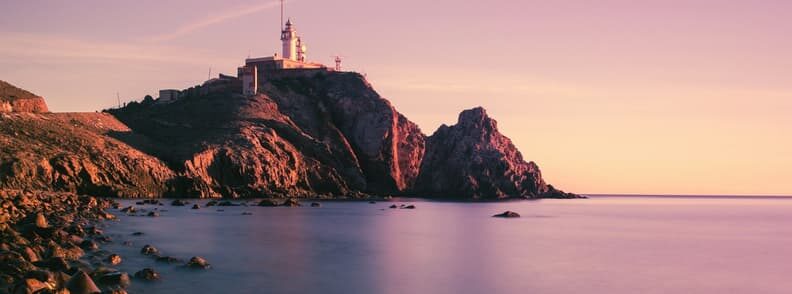
14. Cabo de Gata-Níjar
One of Spain’s most stunning and distinctive natural areas is the Cabo de Gata-Níjar Natural Park in the Andalusia province of Almera. This magnificent park, which spans an area of more than 380 square kilometers and is the largest coastal protected area in Andalusia, is home to some of the most spectacular coastline vistas in all of Europe.
Hiking lovers will love the park’s rough coastline, which is highlighted by towering cliffs, secret coves, and exquisite beaches. From short beach walks to more difficult mountain excursions, the park’s extensive network of hiking paths can accommodate hikers of all skill levels.
Sendero de Los Genoveses is a 7-kilometer journey that passes through some of the park’s most breathtaking vistas, including the pristine beaches of Genoveses and Monsul. This is why this moderate-difficulty trail is one of the most well-liked hiking paths in the area.
The Cabo de Gata-Níjar Natural Park includes a number of strenuous walks for more accomplished hikers, such as the trip to Cerro de Los Frailes’ top, which provides sweeping views of the park and its surroundings. But you should beware: the only travelers who should attempt this challenging trek are seasoned hikers.
In the spring and fall, when temperatures are moderate and the park is at its liveliest, hiking at Cabo de Gata-Níjar Natural Park is recommended. Hiking can be difficult during the summer owing to the high heat, and some of the paths could be blocked because of the risk of forest fires. Although the park might get chilly and windy in the winter, the scenery is still breathtaking.
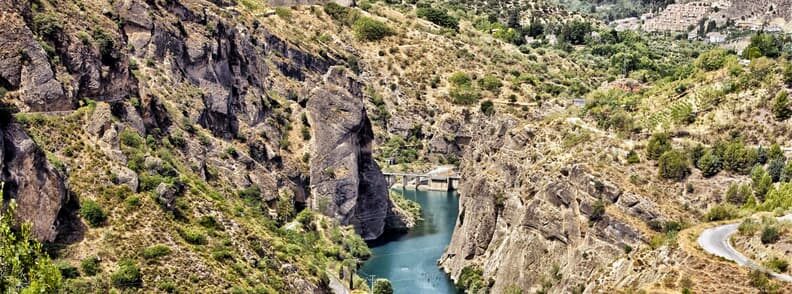
15. Sierra Nevada
The spectacular Sierra Nevada mountain range, which is situated in southern Spain, is home to Mulhacén, the highest point on the Iberian Peninsula, which is 3,479 meters high. But Mulhacén is far from being the only attraction of this Spanish mountain range. In the Sierra Nevada, hiking presents a singular chance to discover the untamed terrain, snow-capped peaks, and breathtaking landscapes.
Depending on the path and the season, hiking in the Sierra Nevada can be challenging. While some paths are appropriate for novices, others call for more advanced fitness and expertise. It’s important to keep in mind, though, that some trails are more difficult than they look on paper due to the greater altitude and rough terrain.
Spring and autumn, specifically between March and June or September and November, are the ideal seasons for hiking in the Sierra Nevada. The trails are not very busy, and the weather is lovely. Temperatures in the summer can go as high as 40°C, while the winter months bring significant snowfall, which can make certain paths impassable.
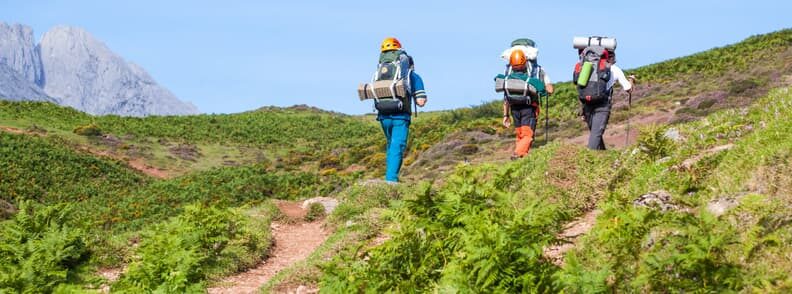
Tips for hiking in Spain
Spain has an abundance of amazing trails to discover. Spain offers everything, from the breathtaking coastline to the untamed mountain ranges. But, it’s important to be ready for your hike wherever you go. We’ll go over some key advice in this part to make sure your hiking trip in Spain is safe and pleasant. These pointers will enable you to get the most out of your excursion regardless of your hiking experience. Now put on your hiking boots and let’s get started!
What to pack for Spain hiking trips
It’s important to pack wisely and have the appropriate equipment while getting ready for a hiking vacation in Spain. The following are some goods you should take for your trip:
- Hiking shoes. Walking across Spain’s trails’ rocky terrain requires a sturdy pair of hiking boots with ankle support.
- Weather-appropriate clothing. Pack layers that will keep you comfortable in a variety of temperatures and weather situations because the climate in Spain can vary dramatically depending on the area. Another essential item is a thin raincoat.
- Sun protection. Pack sunscreen, sunglasses, and a hat to shield yourself from the sun’s damaging rays because Spain is known for its sunny weather.
- Water and food. It’s crucial to stay hydrated when hiking, so pack plenty of water and food to keep yourself energized.
- Tools for navigating the trails. Whether it’s a map, a compass, or a GPS unit, it’s essential to have the right equipment on hand.
- First aid kit. Mishaps can occur on the trails, so bring a first aid kit with you that includes supplies like bandages, disinfectant, and painkillers.
You can make the most of your hiking trip in Spain by packing wisely and bringing the appropriate equipment.
Safety precautions
Although hiking in Spain is exciting, it’s important to put safety first as you explore the trails. Before starting to hike in Spain, bear the following safety advice in mind:
- Plan and prepare. Make careful to investigate the path and determine its complexity before starting out. Choose a path based on your expertise and degree of fitness. Bring the proper attire and equipment after checking the weather prediction.
- Share your plans with others. Let someone know where you’re going, how you plan to get there, and when you anticipate being back. Someone should know where to find you in an emergency.
- Stay on the trail. Getting off the route might be risky, particularly if you’re in an unknown area. Avoid taking shortcuts and stick to the signs and markings.
- Stay hydrated and fueled. Carry lots of water and food with you to keep yourself hydrated and fueled while hiking. The effects of dehydration include weariness and other health problems.
- Respect for the environment and wildlife. This means being aware of your surroundings and taking care not to disturb animals or harm plants and other flora. Pack out any rubbish and leave no trace.
You can guarantee a risk-free and delightful hiking trip in Spain by adhering to these safety guidelines. Always put safety first, and always be ready for anything.
Best time to go hiking in Spain
Passionate travelers who love to hike will love Spain. There are hiking paths to suit all inclinations and abilities thanks to the region’s various environments, which range from rocky highlands to breathtaking coasts. To guarantee the finest experience possible, you should carefully organize your vacation. The season of the year you intend to go is an important consideration.
Where you want to vacation and what you want to see will determine when is the best time to hike in Spain. Generally speaking, the ideal times to visit for hiking are from April to June and from September to November. The weather is moderate throughout these months, and there are fewer visitors. Hiking can be difficult and sometimes dangerous during the summer because of the intense heat, especially in the southern parts. Due to snow and slippery conditions, hiking can sometimes be challenging in the winter, especially at higher elevations.
It’s important to keep in mind that Spain’s northern regions, such as the Picos de Europa and Sierra de Grazalema, receive more rain than the rest of the nation. Typically, spring is the greatest season to travel to these areas since the wildflowers are in bloom and the weather is pleasant. But, it’s still advised to bring the right equipment and be ready for rain.
It is better to avoid the summer months if you intend to trek in Spain’s southern areas, such as Andalusia or the Costa Brava. Hiking becomes difficult and perhaps dangerous when temperatures rise far into the 90s °F (30s °C). These areas are best explored on foot in the spring or fall when the weather is more comfortable.
No matter when you want to walk in Spain, it’s always a good idea to check the weather and the state of the trails first. Be ready for unforeseen weather changes by packing suitable clothing and equipment. Make sure someone is aware of your intended route and anticipated return time, and always pack enough water and food. Hiking in Spain is an enjoyable experience if you plan ahead and prepare.
Local regulations and rules
It’s essential to be informed of the local laws and guidelines that are put in place to safeguard hikers’ safety and the environment when trekking in Spain. The purpose of these regulations is to protect the natural environment and the cultural history of the areas that the paths traverse.
Staying on designated trails is one of the most important rules to follow when hiking in Spain. Departing from the planned route can result in erosion and harm to delicate ecosystems. Also, it’s imperative to refrain from plucking plants or flowers because many species are protected, and doing so might cause their extinction.
Respecting the environment is a further guideline to remember. This includes refraining from trash, agitating nearby wildlife, and creating loud noises that could disturb the peace and quiet. Furthermore, apply proper waste disposal practices and carry out any trash that cannot be dumped on the route.
It is also important to be mindful of any local rules that apply to certain routes or localities. For the protection of animals, certain paths may be restricted at specific seasons of the year, and to avoid overpopulation, others may have daily hiker limits. Before starting any hiking excursion in Spain, it’s necessary to check with the local authorities to make sure you are informed of any restrictions or regulations that can apply.
You can contribute to the long-term preservation of Spain’s hiking routes’ natural beauty and cultural history by abiding by these laws and regulations.
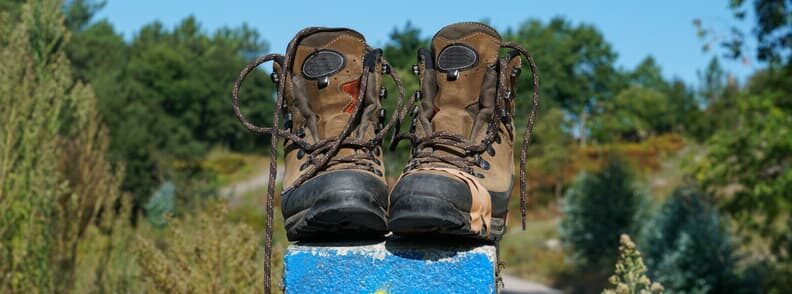
Epic hikes to conquer Spain on the ultimate outdoor adventure
In conclusion, with its varied topography, gorgeous natural parks, and clearly defined routes, Spain is a hiker’s heaven. The 15 finest treks in Spain have been covered, from the strenuous Camino de Santiago to the picturesque Riao and Cabo de Gata-Níjar National Parks. Spain has a variety of hikes for all skill levels, whether you’re a novice or an expert.
Hiking in Spain is a fantastic way to see the country’s natural beauty, be healthy, and get a taste of its fascinating culture and history. Every trek in Spain is a discovery expedition filled with historic monasteries and quaint communities.
Before setting out on your Spanish hiking experience, make sure to pack correctly for the weather and terrain, take safety precautions, and stay informed of local norms and restrictions. Also, consider the optimum time to go trekking based on your tastes and fitness level.
Therefore, this year, why not arrange a hiking trip to Spain? It’s an adventure that will leave you with lasting memories, amazing sights, and a sense of accomplishment. Share this post with your hiking friends, leave a comment on your favorite Spanish hiking site, and begin preparing for your next journey in Spain!
Featured image via depositphotos.com

Mirela Letailleur is a Romanian travel blogger living in the South of France. She writes on The Travel Bunny travel blog about affordable travel in Europe. Creator of unique free travel guides and local travel expert. Problem solver. Wannabe coffee guru.
If you enjoyed reading about hiking Spain, check out
Hiking trip essentials for stress-free travel
Travel checklist for your hiking backpack
Top 10 best road trips in Europe to unleash your inner adventurer

